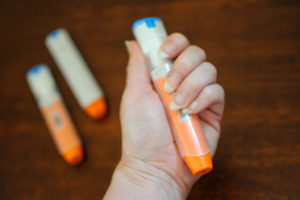
It might not look like much, but it can save a life.
That’s why if you’re having a severe allergic reaction, it’s best to have an epinephrine auto-injector—commonly known by the brand, EpiPen—close at hand.
While the likelihood of having a life-threatening anaphylactic reaction is low, even a mild allergic reaction can be less severe and shorter with the quick jab of an EpiPen, according to Jacqueline Eastman, MD, an allergy and immunology specialist with Spectrum Health Medical Group.
“We’d rather have it available than not available,” Dr. Eastman said.
How can you ensure you and your children and loved ones have it on hand when it’s needed? And how do you use it?
Dr. Eastman answered some important questions about the epinephrine auto-injector.
When do you use it?
If you’re allergic to foods such as nuts, milk, shellfish or eggs, or you’re allergic to medication, insect stings, latex or something else, you might react with a range of symptoms.
This can include itching or irritation of the skin, trouble breathing or anaphylactic shock.
An epinephrine auto-injector is a pen-like device that makes it simple to inject epinephrine, a hormone that works against the allergic reaction. These pens come in a two-pack that can be carried with the patient at all times.
Often, two doses may be needed.
In the case of a bee-venom allergy, a patient might need the second dose of epinephrine as soon as 10 to 15 minutes after the first, Dr. Eastman said. For a food allergy, the second dose could be needed within 30 minutes.
“We do recommend having two and keeping the pack together in case of the risk of not having the first one work well enough,” she said. “Epinephrine wears off very quickly, so you might need another dose before you can get to help, or help can get to you.”
When in doubt, don’t be afraid to use the EpiPen. It won’t hurt the patient, Dr. Eastman said.
“Some families will wait, because they are worried it can do harm,” she said. “The medicine is something your body already has in it.”
The worst that could happen is a rapid heartbeat and feeling a little jittery, she said.
How do you use it?
The auto-injector is designed to deliver the medication, epinephrine, easily and quickly.
“It needs to go in the thigh and you want to use a firm amount of pressure so that it gets in the muscle,” Dr. Eastman said. “Then hold for 10 seconds.”
The auto-injectors come with specific instructions written on the packaging to help in the moment.
Dr. Eastman’s biggest tip: Make a fist over the middle of the EpiPen, with no thumb on the end. That way if you do accidentally jab the wrong end into the thigh, you don’t end up injecting your thumb. If you do use the wrong end, you can just flip it around and try again.
“That’s probably the biggest problem we see,” she said.
If you’re injecting it into a child, she recommends putting one hand on their leg to keep it from moving and then jabbing with the other hand.
“If they pull away or move while you’re injecting them, it could cut them,” she said.
If a child is fearful of the needle or injection, reassure them that it’s going to make them feel much better, Dr. Eastman said.
What if you don’t have one when it’s needed?
Dr. Eastman recommends that those who have been prescribed an EpiPen by their physician try to always have it with them.
That might mean carrying it in a purse or backpack. It might also be best to have multiple EpiPens, so you can keep them in various places.
Also, they are not as unstable in heat and cold as you might think, so it’s better to have it with you regardless of whether it’s within the recommended temperature storage range, she said.
Check the expiration date and try to make sure you always have a valid one. If you’re in a severe situation and all you have is an expired EpiPen, use it anyway, Dr. Eastman said.
If you need an EpiPen while in public and you don’t have one with you, ask around. In the event of an emergency, use whatever EpiPen is available to you.
Dr. Eastman also offers this important message: “If you don’t have it with you, never go home to get it. You always go straight to the hospital.”
The last thing she wants is someone going home for an EpiPen—perhaps to an empty house—and then having nobody to help them.
She also reminds people that all ambulances have EpiPens, as well as police stations and fire stations.
There are several conditions that can make an allergic reaction worse, including being under the influence of alcohol, being sick, using ibuprofen, being under a lot of stress or overly tired.
There is a large population of children with severe allergies who are now becoming adults.
She reminds them to take responsibility for their allergies.
“I always tell young people, ‘If you have been out drinking and you have a reaction, you need to go in to the hospital right away,’” Dr. Eastman said. “I don’t want to hear any argument. There’s no hiding it. You should never be in fear of getting in trouble. Just get help.”
If you can’t afford an EpiPen, speak with your allergist about cost-reducing options, she said.
Bottom line: If you’ve been prescribed an epinephrine auto-injector, that means it’s important to have one handy whenever possible.
Have an action plan for yourself or your children to follow in the event of an allergic reaction.
“If you don’t have it with you, you have lost your opportunity to use it,” she said. “You have wasted time. Stop everything you are doing and get emergency help.”
 /a>
/a>
 /a>
/a>
 /a>
/a>
Auvi-Q is not only a user-friendly epinephrine option (the device actually talks to you), but it is also available at a reduced or no cost fee through the manufacturer website for commercial insurance holders (www.auvi-q.com). I am not an Auvi-Q representative, just a happy to have an affordable option epi-pen carrier.